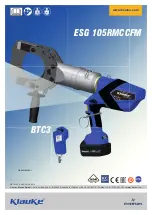
-19-
Check the tool’s seat.
Spindle 1 is locked when the tool is clamped.
Tighten union nut 3 with the open-ended spanner
5
Operation
5.1
Initial operation
Personnel entrusted to work with the power tool must be made aware of the operating manual, calling
particular attention to the chapter “Safety instructions”.
Mount the milling cutter and the milling table before you put the machine into operation.
5.2
Switching on and off
Switching on: Push the switch 5 (Fig. 1) forward until it engages.
Switching off: Push onto the rear end of the switch. The switch jumps into off position.
The built-in electronic system provides for jerk-free acceleration when the machine is switched on and under
load readjusts the speed to the fixed setting.
In addition, this electronic system reduces the motor output in case of an overload, i.e. the spindle stops.
Switch the machine off then. Remove the cause (reduce feed speed, use sharp tool, etc.) and continue to
work.
With the setting wheel 6 (Fig. 2) you can adjust the speed continuously. Appropriate speed values at the
different levels can be referenced in the table on page 4.
5.3
Setting the digging depth
The milling depth can be adjusted continuously by turning the motor unit in relation to the milling table.
-
Release the clamping lever 7 (Fig. 4).
-
Turn the motor unit to adjust the milling depth
-
Clockwise turning = increase milling depth
-
Anti-clockwise turning = decrease milling depth
-
Re-tighten the tension lever
The scale on the milling attachment can be used for fine adjustment.
5.4
Additional limit stop
The additional limit stop 8 (Fig. 3) can be used for machining corners.
-
Pull the additional limit stop 8 (Fig. 3) from its bracket and insert it in the base plate. (Fig. 4)































